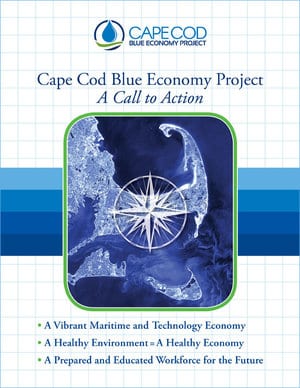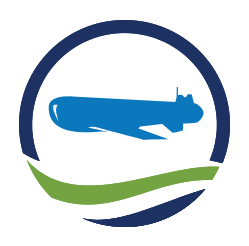
Blue Economy Project Implementation Plan: A Call to Action
The Implementation Plan is a 50+ page report on the origins and profile of the region’s Blue Economy. It dives deep into the data surrounding our coastal economy, and identifies the scope of the Blue Economy throughout the region. It also looks at other Blue Economy initiatives around the world.
The Plan set a vision, a series of three guiding themes, and eight areas of action to enhance the growth of the region’s Blue Economy.
Executive Summary
This report was commissioned by the Cape Cod Blue Economy Project through the Massachusetts Seaport Economic Council, to examine and propose actions that will foster growth in the region’s water-based economy.
The Cape Cod region is defined as southern Plymouth County including Plymouth and Wareham, all of the towns on Cape Cod, and the islands of Martha’s Vineyard and Nantucket. Our efforts to define, characterize, engage and identify actions for the Blue Economy in the Cape region proved very fruitful and encouraging for the future growth of this sector. Our investigations and socialization of the Blue Economy concept resulted in a better understanding of the unique nature of the region and the role that water and healthy environments play in the economy.
Gliding across Cape Cod Bay on the Plymouth-to-Provincetown Fast Ferry, it is abundantly clear how our lives and work are connected to water. The Commonwealth of Massachusetts is known the world around as the “Bay State.” It is more than a convenient motto describing our major landforms. We are a maritime commonwealth – a place formed and matured through our connection to the ocean. This is even more prevalent in the Cape Cod region, stretching from southern Plymouth county across Cape Cod and out to the islands of Martha’s Vineyard and Nantucket.
While the Commonwealth derives 2.6% of direct employment and 1.3% of direct gross state product from the maritime economy[i], the Cape region is more connected, more dependent and more focused on the “blue” or water economy. In fact, the “dark blue” economy, that which is directly dependent on water, in the Cape region is worth 6% of the region’s revenues and employs 4% of the workforce. The top five industries by number of jobs are shellfish fishing, marinas, environmental conservation organizations, finfish fishing and recreational businesses like yacht clubs and charter boats. The top five industries by earnings are manufacturers of instruments for search and navigation, research and development, environmental conservation organizations, environmental consulting services and boat dealers.
More broadly, the Cape region’s overall blue economy is a significant economic driver for the region, representing 12% of jobs and 11% of gross revenues (the complete composition of the gross regional product for Barnstable, Dukes, Nantucket and Plymouth Counties respectively can be found in Appendix A1-A4.) There is predicted growth in dark blue industries through 2022: 2.6% in the region, 4.3% in Cape & Islands Workforce Investment Board (WIB), 16.3% for Dukes County and 12.7% for Nantucket County[ii].
The statistics on the growth of the Cape Cod region’s Blue Economy from 2003 to 2014 are encouraging[iii]:
- The number of blue establishments increased 42% (from 2,180 to 3,104)
- The number of employees employed by blue business increased about 100% (from 14,412 to 29,093)
- Annual payroll for blue businesses increased by 111% (from $574M to $1.21B)
Even more encouraging is that all this growth showed the largest portion in later years, between 2011-2014. Though we have not analyzed the cause of this growth, we believe there is significant room for growth in the Cape Region’s overall Blue Economy.
Throughout this story, you will learn of the interconnectedness of the Cape region’s economy as related to water. You will meet people at work and play here and understand the incredible innovations and worldwide respect generated through its institutions and organizations. You will appreciate its history, present and future. This story makes the case of why implementing the actions developed over a year of intensive research and public debate is the right path. Investing in our communities, our people, our innovations and our ideas will set the course for the future. Our children will understand that this is a great place to live, work, play and create, and that a healthy environment and a healthy economy are one and the same. That we are all in this together. The future of the Cape Region is “blue.”
Join us. Help us realize our collective vision of the future:
The Cape Cod region is driven by the water that surrounds us, steeped in maritime tradition and dedicated to innovation. We are a modern water-based economy that connects people to their environment, inspires learning, and exports our knowledge to the world.
To achieve this vision, the Blue Economy Project will focus work in the following three areas:
[i] UMass Dartmouth Public Policy Center. Navigating the Global Economy: A Comprehensive Analysis of the Massachusetts Maritime Economy.
[ii] See Report Appendix Section X, EMSI Occupational Data
[iii] U.S. Census County Business Patterns 2003–2014
Photo: Lt. Gov. Karyn Polito celebrates opening of DunkWorks at WHOI



